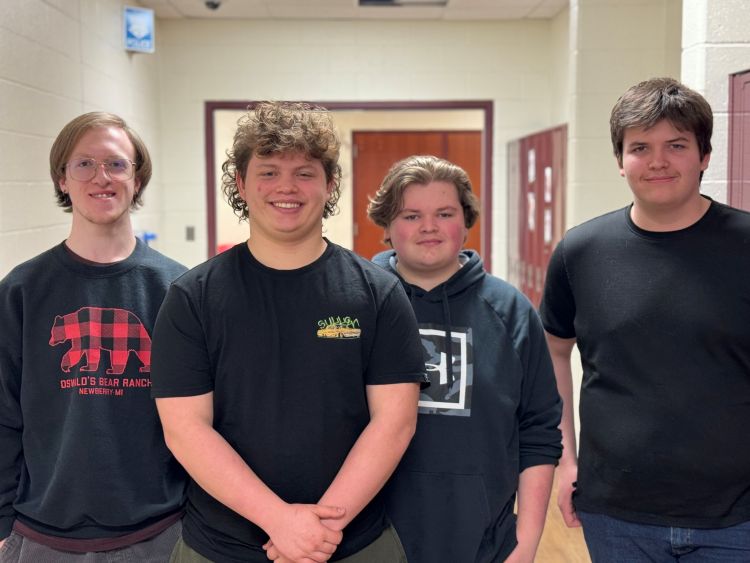Cedar Springs — What can reality television, Marvel movies and Super Bowl halftime shows tell us about the way we perceive the world around us? And how does the world impact our perception of visual media?
These are some of the questions students are itching to answer in a new class at Cedar Springs High School.

Society and Culture through Film and Media is a recent offering from media studies teacher Justin Harnden. Driving the course is a central chicken-and-egg question students will have to answer at the end of the semester: Does culture shape media, or is it the other way around?
Of course it’s tempting to say “both,” but Harnden said that’s not an option for students.
“There’s not a right answer, but they have to pick one side and argue that aspect of it with resources and references from everything we’ve done throughout this semester,” Harnden said. “In reality, it’s a two-way street where they work hand in hand. But I’m going to make them pick a side.”
He likened the culminating assignment to making a legal case in court: “You’ve got to defend it, whether you want to or not.”
So far students have watched movies such as “The Truman Show,” “Mean Girls” and “Black Panther,” reality shows like “Jersey Shore,” and rapper Kendrick Lamar’s headlining halftime performance at Super Bowl LIX, among other pieces of visual media.
‘… through this class I’ve started to see that there’s deeper meanings to shows and movies, and they can actually influence communities and societies.’
— sophomore Aiden Wood
And while it might be fun, it’s also pretty academically rigorous, Harnden said. Assignments accompany each viewing, ranging from quizzes and in-class group discussions to student-created slide presentations breaking down and analyzing key themes in the material.
The course is designed to help develop the kind of critical thinking skills that will aid students in college, or in the working world.
Seeing the Deeper Meanings
Though it’s only its first semester, the class is already a hit with the sophomores, juniors and seniors who make up its first group. Students said it’s challenging them to rethink how they interact with media, and to consume it with a critical eye.
‘You talk to people more and understand where they’re coming from. It’s a nice mixing pot, and that’s what I really appreciate about the class.’
— junior Nolan Carlton
“At first, I would just watch movies and not really look into the depths and meanings that they actually portray,” said sophomore Aiden Wood, “but through this class I’ve started to see that there’s deeper meanings to shows and movies, and they can actually influence communities and societies.”
Aiden said “The Truman Show” helped him comprehend the degree to which what we see and hear on a day-to-day basis can form and mold our impressions of reality.
“The Truman Show” has also been a highlight for junior Zackery Haack, who shared a different takeaway from the film.
“It showed how much we normalize surveillance,” Zackery said. “Truman’s constantly being surveilled and watched. Who’s to say that anybody else isn’t constantly being surveilled and watched?”

The way the class exposes students to these differing interpretations is one of its major selling points, said junior Nolan Carlton.
“Everyone has their own opinion they get to share, and you talk to people more and understand where they’re coming from,” Nolan said. “It’s a nice mixing pot, and that’s what I really appreciate about the class.”
Sophomore Jaxon Gross said he initially signed up for the course because he liked Harnden’s teaching style. But once he really dug in, he found that all the discussions helped him on a personal level.
“I struggle with talking and social anxiety, but this class has completely helped me in learning how to discuss more, talk about my opinion, stuff like that,” he said.
Senior Coco Schneider, an exchange student from Germany, noted that some of the films viewed in class have shed a light on how other countries develop their impressions of American culture. Movies like “Mean Girls,” she said, reinforce simplistic views about American high-school students and how they behave and interact.
“You have those really, really rich girls that try to keep each other down,” said Coco. “That kind of feeds the stereotypes that people in Germany have of the U.S.”
Well, Which is It?
As for the central question about whether society or media has a bigger impact, students are leaning toward society.

“I’m definitely going to pick society, because you’re always going to see movement and change in society before film and media picks it up,” said Coco.
“It’s hard to pick one side, but I think it’s society,” said Jaxon.
“Media just reflects and amplifies what society does, because media doesn’t have original thought,” Zack added.
Harnden is eager to hear the rationale students use to defend their positions at the end of the semester. He said one thing he really wants to instill in students is an ability to use logic, reason and evidence to support their arguments.
“I want them to really have a vested approach, where it’s not just like, ‘I think this,’” he said. “No, you have to rationalize it, justify it, support your decision, support your answers and go from there.”
Harnden said he’s grateful that the district has given him the freedom to introduce the class. He plans to continue it in the fall, and student interest is already high for future semesters.
Read more from Cedar Springs:
• Marching band takes talents to Magic Kingdom
• ‘It’s about personal improvement’: Fitness program gains traction









